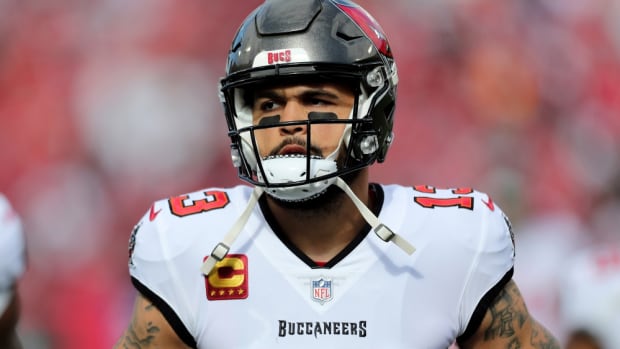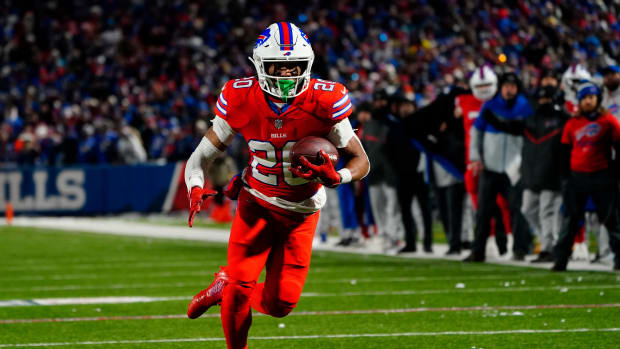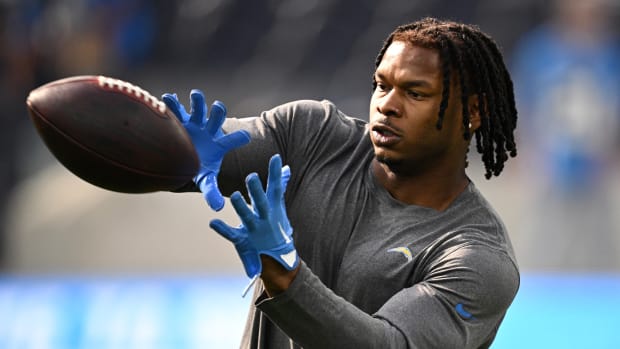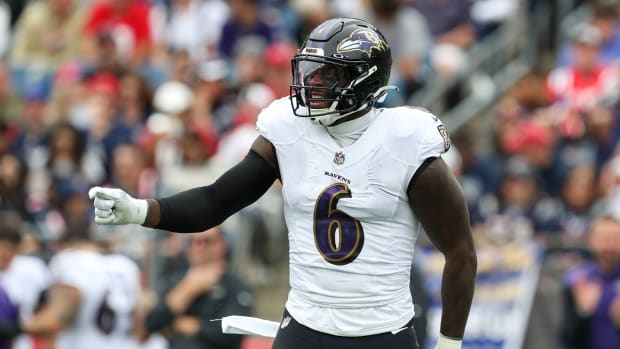
Getting Down to Business
The two quarterbacks in the NFC Championship Game, San Francisco's Colin Kaepernick and Seattle's Russell Wilson, are due to make less than $2 million combined in 2014. (Marcio Jose Sanchez/AP)
We have reached the time of year where the business of the NFL exists in a state of limbo, sandwiched between the end of the 2013 season and the start of the 2014 league year, beginning in March. The 20 teams that played their last game on Dec. 29 have long since turned the page and are well into preparations for 2014 (with seven of them changing coaches). Even for those teams still competing, management is planning out personnel and financial moves for when the bell rings March 11 at 4 p.m. Eastern.
With many questions at this important time of year in the business of the NFL, here are answers to the most frequent ones I receive through Twitter (@adbrandt), starting with one about the low pay for the quarterbacks in the NFC Championship Game:
Could you explain why the Seahawks and 49ers have a cap advantage with their quarterbacks?
Russell Wilson and Colin Kaepernick have scheduled 2014 salaries of $662,000 and $974,000, respectively, in the third and fourth years of mandatory four-year contracts required for all draft choices per the CBA. And, in Wilson’s case, there is no opportunity to improve his financial situation until 2015, as the CBA further requires three seasons played for drafted rookies before the prospect of an improved contract. Kaepernick, a year ahead of Wilson, would be able to renegotiate should the 49ers choose, yet the 49ers have the leverage of a year remaining at less than $1 million.
These fixed and reasonable rates at the game’s most important position give the Seahawks and 49ers valuable flexibility and resources to use in their short-term team building. It is no coincidence that they were two of the most active teams in the NFL this offseason, with acquisitions including Anquan Boldin in San Francisco and Michael Bennett, Cliff Avril and Percy Harvin in Seattle.
Solid drafting, player development and securing core players to long-term extensions are keys to sustained success in the NFL. That strategy is made easier with premier quarterbacks in rookie contracts, allowing resource allocation to core veterans in second or third contracts. Wilson and Kaepernick’s fixed and reasonable rates give the Seahawks and 49ers beneficial elasticity in managing their roster.
But what about when the teams have to pay Wilson and Kaepernick?
This is a valid concern, and certainly one anticipated by the Seahawks and 49ers. Good management, which both teams clearly have, projects out various scenarios for future spending, staggering larger contracts and projecting deletions of expensive veterans down the road. Both teams are certainly planning around that prospect. For instance, the Seahawks know they might not have the luxury of acquiring short-term veteran quick-fixes such defensive ends Bennett and Avril, who are making a combined $11 million this year, and will look to develop that position through the draft. And the 49ers are always thinking toward the future, even using draft picks on future assets such as “redshirt” running back Marcus Lattimore.
Yes, there will likely come a day when the cap and cash numbers of the quarterbacks in the NFC Championship Game will look like those of the quarterbacks in the AFC Championship Game, Tom Brady and Peyton Manning. The Seahawks and 49ers’ preparation for that prospect and strategic development of the roster around Wilson and Kaepernick—assuming their continued strong play—will determine how long this run of sustained success continues.
Peyton Manning made $18 million in the regular season, and $23,000 so far in the playoffs. (Christian Petersen/Getty Images)
How is postseason pay calculated?
The playoffs are league (not team) events, with player compensation from NFL coffers transferred to team accounts to disburse to players soon after their last playoff game. Playoff pay is outlined in the CBA, with designated amounts for all players; player contract amounts for the season are irrelevant. For example, while Peyton Manning earned $1.18 million per week during the season according to his $20 million salary, he has earned $0 and $23,000 for the past two weeks in the playoffs, the same as every other Bronco. Here are the cumulative amounts for postseason pay for this postseason:
Wild-Card Round, Division Winner: $23,000 per player
Wild-Card Round, Wild Cards: $21,000
Divisional Playoff Game: $23,000
Conference Championship Game: $42,000
Super Bowl, Winner: $92,000
Super Bowl, Loser: $46,000
Players on teams with first-round byes do not get paid that week (though practice-squad players still get their stipends). Thus, the maximum a player can make for winning the Super Bowl is $180,000, with a maximum of $157,000 for players from teams receiving first-round byes.
If the NFL expands the playoffs, would players receive more postseason pay?
Yes, but not a lot. Another set of teams in the playoffs would require the league to factor in additional payments similar to those listed above for the wild-card round, relatively trivial numbers for the league.
On a macro level, NFL postseason revenue is shared with the players in the CBA calculation of each year’s salary cap. Thus, new revenue from expanded playoffs would factor into the owner/player revenue split. But as to whom would benefit more from expanded playoffs, the owners or players, it is safe to say it would be the side advancing that discussion, the owners. And the NFL would not have to collectively bargain expanded playoffs or renegotiate postseason pay.
Is the NFL considering reseeding the teams?
No. That is a nonstarter with Roger Goodell, who has repeatedly mentioned rewarding teams for winning their division. As for the inequities that are always pointed out this time of year, the league’s position is that this is cyclical and eventually evens out, with division strength varying year to year.
What are reserve/future contracts now being signed?
In this transitory period following the end of the 2013 season, but before 2014 business can be transacted, contracts now being signed do not technically activate until the start of the league year. Thus, between now and March 11, they are in this reserve/future category. These players fill out the roster and will report for offseason workouts in April.
Most reserve/future players were on practice squads during the 2013 season and are re-signing “real” contracts with the same team, although a few will sign with a different team for a perceived better opportunity. Unfortunately, the majority of these players will do everything asked by their team over the next eight months yet likely will be released by Labor Day.
Although it is rare, teams can uncover some true gems. One such player we signed at the Packers as a reserve/future was Cullen Jenkins, who went on to be a highly productive player for the Packers, Eagles and now Giants.
Lovie Smith still was being paid by the Bears in 2013, even though he'd been fired after the 2012 season. (Al Messerschmidt/Getty Images)
Why aren’t player contracts guaranteed like coaching contracts?
As with any negotiation, it is much harder to change the status quo than to maintain it, especially with something as important as future guaranteed earnings. Coaches’ contracts, for as long as I can remember, have been guaranteed, perhaps due to the peripatetic nature of their itinerant lives.
Interestingly, the coaches do not have a union (although they have agents) while the players do.
If a coach is fired by one team and then hired by another, does he get salary from two teams?
Virtually all coach contracts have “offset language” in their contracts, reducing the first team’s obligation by the amount of compensation received from a new team. For example, were a coach fired with one year remaining at a salary of $1 million remaining then hired by another team for $400,000, the original club’s financial obligation would be $600,000.
Offsets can create some sticky situations for both the team and the coach moving forward. Once fired, the coach is contractually required to diligently try to secure another job. These can lead to some tense conversations between the firing team and the coach about his attempts to earn other income, especially when a coach decides to sit out rather than accept what he considers an undesirable opportunity.
Offsets can also create thorny dealings between teams regarding suitable pay for coaches. I have seen situations where a team has tried to pay a nominal amount to the coach, knowing the firing team is paying the rest (and the coach, fired by the first team, is happy to oblige). The NFL reluctantly will intervene to determine reasonable compensation based on a coach’s experience and qualifications. The NFL is a very small world; teams that use these tactics get reputations.
What happened this week with the concussion settlement? Is there a snag?
There is a snag, but it should be resolved soon. Judge Anita Brody denied preliminary approval of the historic settlement of $765 million between the NFL and all retired players. In a 12-page opinion, she expressed concerns about the sufficiency of the funds for the settlement going forward, a period designated at 65 years. While the lawyers said that their economists had stated the funds were sufficient, they did not provide documentation in their request for preliminary approval, as if to say, “Take our word for it.” Judge Brody wants such documentation submitted to her Special Master, an accountant assisting in the financial intricacies of the settlement.
Judge Brody expressed specific concern about the adequacy of the BAP Fund (Baseline Assessment Program), a $75 million allocation toward baseline evaluations and medical monitoring that retired players will undergo to determine the existence and extent of any cognitive deficits. She wants assurance that the sum will be enough for players even decades from now. Further, as part of the settlement, there is also language in the agreement preventing retirees from suing the NCAA and other amateur football organizations, which further concerns Brody.
As to why the attorneys failed to provide documentation on the sufficiency of the funds, my sense is that 1) they thought preliminary approval was merely a formality; or 2) there are concerns that there might not be enough money. If it is the former and documentation is forthcoming, this is merely a minor speed bump toward gaining approval. If it is the latter, that is a very real concern.
Why wouldn’t the two sides just agree that if there is more money needed for the players, it would be provided?
The NFL will not agree to that. They settled this case with a finite number in mind and do not want future commitments lingering. As I said at the time regarding the settlement, this was a negotiation, nothing more and nothing less. The plaintiffs certainly wanted to settle for a number in the billions, but NFL owners negotiated it down to $765 million, plus attorneys’ fees. That is the extent of their commitment.
Let’s be clear: the concussion settlement is not blowing up; this is more of a speed bump than a major detour. However, it is apparent that Judge Brody will require greater specificity, detail and documentation than the attorneys were expecting as this settlement plods along toward final approval. Next step: plaintiff lawyers will deliver a documented economic forecast within, I am told, “10 days or so.”
One thing is clear: no retired player is receiving any money from the settlement anytime soon.








































